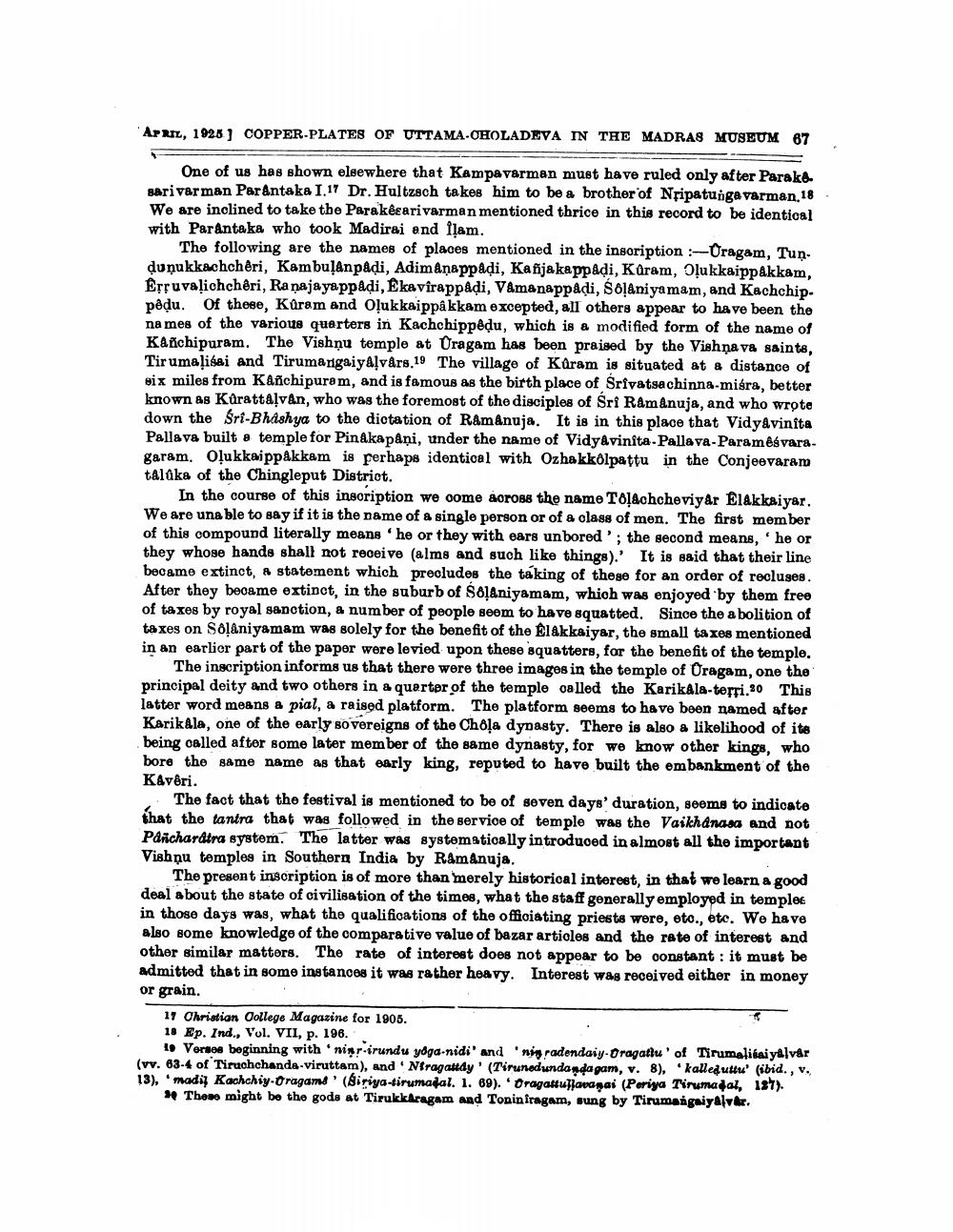________________
APRIL, 1925] COPPER-PLATES OF UTTAMA-CHOLADEVA IN THE MADRAS MUSEUM 67
One of us has shown elsewhere that Kampavarman must have ruled only after Parake. sarivarman Parântaka I.17 Dr. Hultzsch takes him to be a brother of Nripatungavarman.18 We are inclined to take the Parakêsari varman mentioned thrice in this record to be identical with Parantaka who took Madirai and flam.
The following are the names of places mentioned in the insoription :-Uragam, Tundunukkachcheri, Kambulânpadi, Adimanappadi, Kañjakappadi, Karam, Olukkaippakkam, Erruvalichcheri, Ranajayappadi, Ekavtrappadi, Vamanappadi, 80lAniyamam, and Kachchippêdu. Of these, Kûram and Olukkaippakkam excepted, all others appear to have been the names of the various quarters in Kachchippêdu, which is a modified form of the name of Kanchipuram. The Vishnu temple at Uragam has been praised by the Vishnava saints, Tirumalisai and Tirumangaiyalvårs.19 The village of Kuram is situated at a distance of six miles from Kanchipuram, and is famous as the birth place of Srivatsa chinna-miśra, better known as Kurattalvan, who was the foremost of the disciples of Sri Ramanuja, and who wrote down the Sri-Bhashya to the dictation of Ramanuja. It is in this place that Vidyavinita Pallava built a temple for Pinakapani, under the name of Vidyavinita-Pallava-Paramêsvaragaram. Olukkaippakkam is perhaps identical with Ozhakkôlpattu in the Conjeevaram talûka of the Chingleput District.
In the course of this inscription we come across the name Tolachcheviyâr Elakkaiyar. We are unable to say if it is the name of a single person or of a class of men. The first member of this compound literally means 'he or they with ears unbored'; the second means,' he or they whose hands shall not receive (alms and such like things).' It is said that their line became extinct, a statement which precludes the taking of these for an order of recluses. After they became extinct, in the suburb of Sôlaniyamam, which was enjoyed by them free of taxes by royal sanction, a number of people seem to have squatted. Since the abolition of taxes on Sôlâniyamam was solely for the benefit of the Elakkaiyar, the small taxes mentioned in an earlier part of the paper were levied upon these squatters, for the benefit of the temple. The inscription informs us that there were three images in the temple of Oragam, one the principal deity and two others in a quarter of the temple called the Karikala-terri.20 This latter word means a pial, a raised platform. The platform seems to have been named after Karikala, one of the early sovereigns of the Chola dynasty. There is also a likelihood of its being called after some later member of the same dynasty, for we know other kings, who bore the same name as that early king, reputed to have built the embankment of the K&vêri.
The fact that the festival is mentioned to be of seven days' duration, seems to indicate that the tantra that was followed in the service of temple was the Vaikhanasa and not Pancharatra system. The latter was systematically introduced in almost all the important Vishnu temples in Southern India by Ramanuja.
The present inscription is of more than merely historical interest, in that we learn a good deal about the state of civilisation of the times, what the staff generally employed in temples in those days was, what the qualifications of the officiating priests were, etc., etc. We have also some knowledge of the comparative value of bazar articles and the rate of interest and other similar matters. The rate of interest does not appear to be constant: it must be admitted that in some instances it was rather heavy. Interest was received either in money or grain.
17 Christian College Magazine for 1905.
18 Ep. Ind., Vol. VII, p. 196. 1
19 Verses beginning with ninr-irundu yoga-nidi' and 'nig radendaiy-Oragattu' of Tirumalisaiyalvar (vv. 63-4 of Tiruchchanda-viruttam), and Ntragattdy' (Tirunedundandagam, v. 8), kalleḍuttu' (ibid., v., 13), madil Kachchiy-Oragams (Biriya-tirumadal. 1. 69). Oragattuljavanai (Periya Tirumadal, 187).
3 These might be the gods at Tirukkaragam and Toninfragam, sung by Tirumangaiyalvar.




